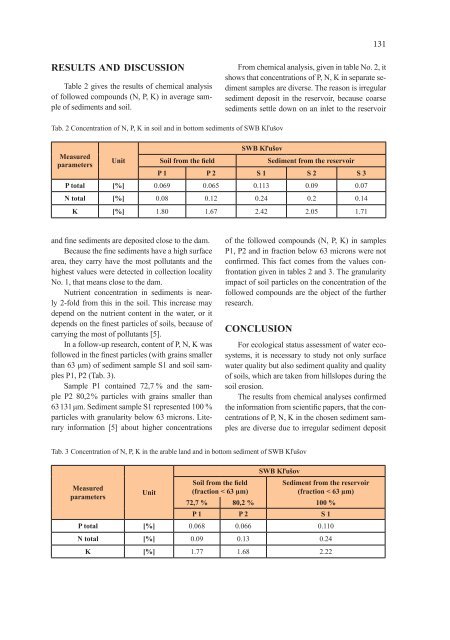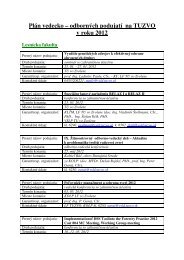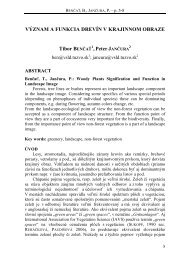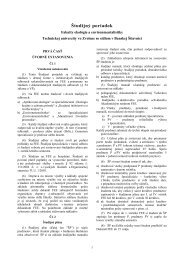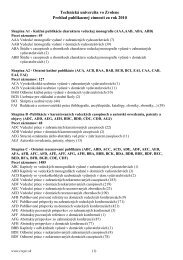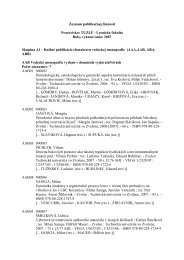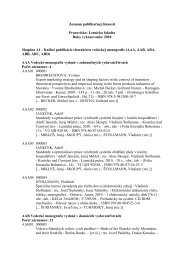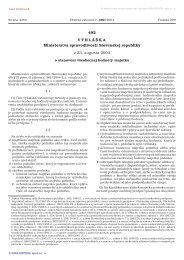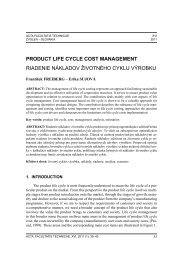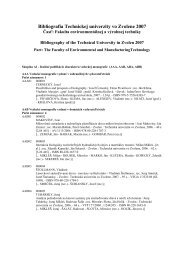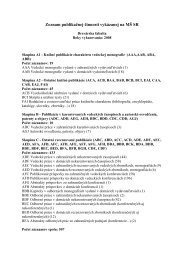Acta Facultatis Ecologiae - Technická univerzita vo Zvolene
Acta Facultatis Ecologiae - Technická univerzita vo Zvolene
Acta Facultatis Ecologiae - Technická univerzita vo Zvolene
- No tags were found...
You also want an ePaper? Increase the reach of your titles
YUMPU automatically turns print PDFs into web optimized ePapers that Google loves.
131RESULTS AND DISCUSSIONTable 2 gives the results of chemical analysisof followed compounds (N, P, K) in average sampleof sediments and soil.From chemical analysis, given in table No. 2, itshows that concentrations of P, N, K in separate sedimentsamples are diverse. The reason is irregularsediment deposit in the reser<strong>vo</strong>ir, because coarsesediments settle down on an inlet to the reser<strong>vo</strong>irTab. 2 Concentration of N, P, K in soil and in bottom sediments of SWB KľušovSWB KľušovMeasuredparametersUnit Soil from the fieldSediment from the reser<strong>vo</strong>irP 1 P 2 S 1 S 2 S 3P total [%] 0.069 0.065 0.113 0.09 0.07N total [%] 0.08 0.12 0.24 0.2 0.14K [%] 1.80 1.67 2.42 2.05 1.71and fine sediments are deposited close to the dam.Because the fine sediments have a high surfacearea, they carry have the most pollutants and thehighest values were detected in collection localityNo. 1, that means close to the dam.Nutrient concentration in sediments is nearly2-fold from this in the soil. This increase maydepend on the nutrient content in the water, or itdepends on the finest particles of soils, because ofcarrying the most of pollutants [5].In a follow-up research, content of P, N, K wasfollowed in the finest particles (with grains smallerthan 63 μm) of sediment sample S1 and soil samplesP1, P2 (Tab. 3).Sample P1 contained 72,7 % and the sampleP2 80,2 % particles with grains smaller than63 131 μm. Sediment sample S1 represented 100 %particles with granularity below 63 microns. Literaryinformation [5] about higher concentrationsof the followed compounds (N, P, K) in samplesP1, P2 and in fraction below 63 microns were notconfirmed. This fact comes from the values confrontationgiven in tables 2 and 3. The granularityimpact of soil particles on the concentration of thefollowed compounds are the object of the furtherresearch.CONCLUSIONFor ecological status assessment of water ecosystems,it is necessary to study not only surfacewater quality but also sediment quality and qualityof soils, which are taken from hillslopes during thesoil erosion.The results from chemical analyses confirmedthe information from scientific papers, that the concentrationsof P, N, K in the chosen sediment samplesare diverse due to irregular sediment depositTab. 3 Concentration of N, P, K in the arable land and in bottom sediment of SWB KľušovSWB KľušovSoil from the field Sediment from the reser<strong>vo</strong>irMeasuredUnit(fraction < 63 µm)(fraction < 63 µm)parameters72,7 % 80,2 % 100 %P 1 P 2 S 1P total [%] 0.068 0.066 0.110N total [%] 0.09 0.13 0.24K [%] 1.77 1.68 2.22


